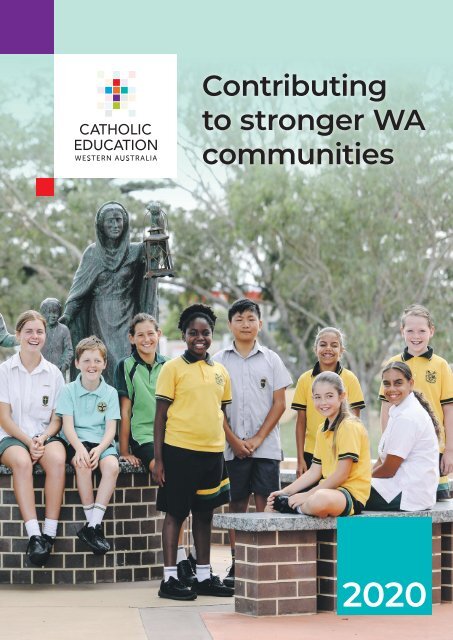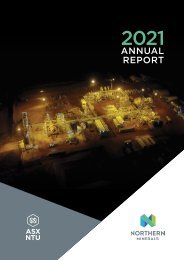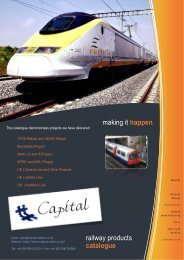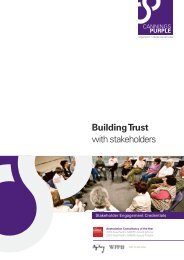Contributing to Stronger WA Communities
Create successful ePaper yourself
Turn your PDF publications into a flip-book with our unique Google optimized e-Paper software.
<strong>Contributing</strong><br />
<strong>to</strong> stronger <strong>WA</strong><br />
communities<br />
2020
Contents<br />
03.<br />
Foreword<br />
By Dr Debra Sayce<br />
Executive Direc<strong>to</strong>r CE<strong>WA</strong><br />
04.<br />
At a Glance<br />
05.<br />
Flagship<br />
Initiatives<br />
06.<br />
Supporting<br />
Parental<br />
Choice<br />
08.<br />
<strong>Contributing</strong><br />
<strong>to</strong> Western<br />
Australia's<br />
Economy<br />
10.<br />
Partners in<br />
Our State's<br />
Future
Foreword<br />
BY DR DEBRA SAYCE<br />
Executive Direc<strong>to</strong>r CE<strong>WA</strong><br />
Catholic schools have been an important part of Western<br />
Australia’s education landscape since 1844. As the second<br />
largest education provider in the state, the Catholic<br />
education system provide educational options and quality<br />
school opportunities for 18% of the State’s <strong>to</strong>tal school<br />
student population, including 23% of all secondary<br />
school students.<br />
In 2019, more than 76,000 students were enrolled at 162<br />
Catholic schools located from Wyndham in the state’s<br />
north <strong>to</strong> Albany and Esperance on the south coast, and<br />
inland <strong>to</strong> Kalgoorlie. Catering for families from a spectrum<br />
of social and economic backgrounds, Catholic schools<br />
provide educational choice for all families seeking a Catholic<br />
education for their children, regardless of their individual<br />
circumstances or their capacity <strong>to</strong> financially contribute.<br />
For more than 175 years, as long as some of the State’s<br />
oldest Catholic schools have served their local communities,<br />
<strong>WA</strong> parents have exercised their freedom <strong>to</strong> choose schools<br />
that articulate the values they believe are important <strong>to</strong> their<br />
children’s intellectual, spiritual and social development.<br />
In fostering these values, Catholic schools recognise<br />
that a quality education is built on a strong home-school<br />
partnership. Catholic schools support, and are supported<br />
by, effective parent and community relationships that give<br />
direction and purpose <strong>to</strong> their pas<strong>to</strong>ral roles.<br />
Parents in Catholic schools make a significant contribution<br />
<strong>to</strong> their children’s education, saving the Federal and<br />
State governments millions of dollars annually. In 2019,<br />
this resulted in a net saving of $262 million <strong>to</strong> Federal<br />
Government and $611 million <strong>to</strong> State Government in<br />
recurrent costs alone.<br />
In addition <strong>to</strong> the significant financial savings for the<br />
State and Federal governments, Catholic schools make<br />
a far-reaching contribution <strong>to</strong> the <strong>WA</strong> economy. In 2019,<br />
independent analysis undertaken by Ernst & Young<br />
estimated that Catholic Education Western Australia (CE<strong>WA</strong>)<br />
supported approximately 11,000 full time teaching and<br />
non-teaching jobs resulting in an estimated Gross Value<br />
Add of $1.64 billion.<br />
CE<strong>WA</strong> values the State Government’s commitment <strong>to</strong><br />
ensuring all students – regardless of where they live –<br />
receive a high-quality education. To ensure all schools,<br />
including Catholic schools, can better support the growing<br />
student population in contemporary, world class facilities,<br />
CE<strong>WA</strong> is seeking a commitment from the major political<br />
parties for continued support and recognition of a diverse<br />
and strong non-government schooling sec<strong>to</strong>r, enabling<br />
choice for <strong>WA</strong> families. Parents, who are prepared <strong>to</strong><br />
financially invest in their children’s education, expect<br />
Federal and State governments <strong>to</strong> support their<br />
legitimate educational choices through equitable funding<br />
and supportive policies for all schools – government<br />
and non-government.<br />
This report highlights the significant role of Catholic<br />
education in Western Australia, evidenced not only In the<br />
financial contribution <strong>to</strong> the economy but more importantly<br />
in preparing children and young people <strong>to</strong> positively<br />
contribute <strong>to</strong> society well in<strong>to</strong> the future.<br />
'Partners in our State's future' wraps up the report, outlining<br />
the key challenges facing Catholic schools as CE<strong>WA</strong> calls<br />
for renewed Government support for fair and equitable<br />
investment for students attending Catholic schools.<br />
Catholic Education Western Australia | 3
At a Glance<br />
Catholic schools come in all sizes, from small country schools <strong>to</strong> large<br />
metropolitan Kindergartens <strong>to</strong> Year 12 colleges. More than 34% of <strong>WA</strong>’s<br />
Catholic schools are located outside major metropolitan areas. In some<br />
remote communities, a Catholic school is the only local school.<br />
13<br />
CE<strong>WA</strong><br />
SCHOOLS<br />
Diocese of<br />
Broome<br />
Providing an education that strives <strong>to</strong> educate<br />
the whole child – intellectually, spiritually,<br />
physically, morally and emotionally –<br />
is a priority for Catholic schools.<br />
More than<br />
76,000<br />
students attend a Catholic school<br />
11<br />
CE<strong>WA</strong><br />
SCHOOLS<br />
112<br />
CE<strong>WA</strong><br />
SCHOOLS<br />
27<br />
CE<strong>WA</strong><br />
SCHOOLS<br />
Diocese of<br />
Gerald<strong>to</strong>n<br />
Archdiocese of Perth<br />
Diocese of<br />
Bunbury<br />
18% of all <strong>WA</strong> school students Catholic schools<br />
meet students'<br />
diverse needs<br />
That's<br />
15%<br />
of all <strong>WA</strong> primary<br />
school students<br />
75<br />
schools offer<br />
Three-year-old<br />
programs<br />
and<br />
23%<br />
of all <strong>WA</strong> secondary<br />
school students<br />
133<br />
schools have<br />
Kindergarten<br />
programs<br />
13<br />
Aboriginal Families as First<br />
Educa<strong>to</strong>rs (AFaFE) playgroups<br />
24<br />
schools offer<br />
Education<br />
Support<br />
Centres<br />
12<br />
schools provide<br />
boarding<br />
services<br />
68<br />
schools provide<br />
Outside School<br />
Hours Care<br />
4<br />
schools offer<br />
Long<br />
Day Care<br />
147<br />
schools provide<br />
support for<br />
Aboriginal<br />
students<br />
5support secondary<br />
students <strong>to</strong><br />
re-engage in their<br />
learning at specialist<br />
CARE (Curriculum<br />
and Re-engagement<br />
Education) schools<br />
4 | <strong>Contributing</strong> <strong>to</strong> stronger <strong>WA</strong> communities
Flagship Initiatives<br />
CE<strong>WA</strong>'s flagship initiatives support schools <strong>to</strong> achieve<br />
their vision of being Christ-centred and child-focused<br />
communities and engaged learning environments.<br />
Child Safe Framework<br />
The Child Safe Framework, launched in 2018, promotes work<br />
practices and establishes expectations for personal and<br />
professional boundaries that support a child safe culture<br />
for all Catholic schools, care centres and communities.<br />
Based on the latest research in child safety for institutions,<br />
in line with best practice, and consistent with the Royal<br />
Commission in<strong>to</strong> Institutional Responses <strong>to</strong> Child Sexual<br />
Abuse recommendations, the nine elements of the Child<br />
Safe Framework support our school communities in<br />
maintaining child-safe cultures founded on healthy and<br />
respectful relationships.<br />
Transforming Lives: Strategy 2025<br />
With over 3100 Aboriginal students and more than 100<br />
Aboriginal Teaching Assistants in Catholic schools across<br />
Western Australia, and the system-wide key initiative<br />
of Transforming Lives: Strategy 2025, CE<strong>WA</strong> is committed<br />
<strong>to</strong> creating outstanding, culturally responsive learning<br />
environments for young Aboriginal people and their families.<br />
Vision for Learning<br />
Launched in 2019, Vision for Learning articulates our<br />
commitment <strong>to</strong> a quality Catholic education which is<br />
Christ-centred and child-focused. It envisages the learning<br />
journey of young people as they develop strong academic<br />
skills and learn <strong>to</strong> collaborate, innovate and think critically<br />
in order <strong>to</strong> contribute positively <strong>to</strong> a rapidly changing world.<br />
The Vision for Learning is underpinned by research and by<br />
the experience of nationally and internationally acclaimed<br />
practitioners. It recognises the important role parents<br />
play as partners in the education of young people, and the<br />
importance of all educa<strong>to</strong>rs <strong>to</strong> bring the vision <strong>to</strong> life in<br />
following their vocation. The Vision for Learning is aligned <strong>to</strong><br />
the domains of CEC<strong>WA</strong>’s Strategic Directions 2019-2023.<br />
Digital Transformation<br />
CE<strong>WA</strong>'s multi-year digital transformation project has<br />
enabled a world-class digital ecosystem that provides safe<br />
and secure cloud-based collaboration and insights for staff<br />
and students. The platform has received local, national and<br />
international acclaim.<br />
The strategy strives <strong>to</strong> ensure Aboriginal students have<br />
equitable access and participation in Catholic schools,<br />
and every opportunity <strong>to</strong> achieve educational outcomes<br />
equal <strong>to</strong> that of their non-Aboriginal peers.<br />
CEC<strong>WA</strong> Strategic Directions<br />
Responding <strong>to</strong> God’s call <strong>to</strong> serve our diverse communities<br />
1<br />
CATHOLIC IDENTITY<br />
2 EDUCATION<br />
3 COMMUNITY<br />
4 STE<strong>WA</strong>RDSHIP<br />
a<br />
b<br />
c<br />
Inspiring<br />
Christ-centred<br />
Leaders<br />
Contemporary models of Gospel<br />
leadership that are inclusive,<br />
flexible and responsive <strong>to</strong> the<br />
increasing requirements of<br />
church, governments and society.<br />
Shared leadership and<br />
governance practices that<br />
embrace Catholic Social Teaching<br />
principles emphasising common<br />
good, participation, subsidiarity<br />
and co-responsibility.<br />
Inclusive leadership formation<br />
and development reflecting the<br />
commitment and diverse talents<br />
of staff, students, parents and<br />
community members.<br />
a<br />
b<br />
c<br />
d<br />
Catholic Schools<br />
of Excellence<br />
Effective communities<br />
developing students as<br />
whole Christian persons.<br />
Catholic schools witnessing<br />
effective, contemporary<br />
pedagogy and mission-inspired<br />
practice and outreach.<br />
Shared understanding and<br />
commitment <strong>to</strong> a Catholic<br />
Vision for Learning across<br />
all schools.<br />
Commitment <strong>to</strong> providing high<br />
quality Religious Education.<br />
a<br />
b<br />
c<br />
d<br />
Catholic Pas<strong>to</strong>ral<br />
<strong>Communities</strong><br />
Inclusive communities<br />
welcoming and supporting<br />
students with diverse learning<br />
and social needs.<br />
Shared understanding and<br />
commitment <strong>to</strong> the Transforming<br />
Lives: Strategy 2025.<br />
Open processes for conversation<br />
and engagement with all<br />
members of CE<strong>WA</strong> communities<br />
and their local church.<br />
Services <strong>to</strong> enhance the safety<br />
and wellbeing of students and<br />
staff across all contexts.<br />
a<br />
b<br />
c<br />
Accessible,<br />
Affordable and<br />
Sustainable System<br />
of Schools<br />
Initiatives ensuring the<br />
accessibility, affordability,<br />
sustainability and growth<br />
of schools.<br />
Transparent and<br />
inclusive processes for<br />
distributing resources that build<br />
equity and<br />
co-responsibility across<br />
all schools.<br />
Responsiveness <strong>to</strong> the diverse<br />
needs of students.<br />
Catholic Education Western Australia | 5
Supporting Parental Choice<br />
Affordability<br />
Catholic schools are as diverse as the communities they serve, catering<br />
for families from a variety of social and economic backgrounds.<br />
Acknowledging the significant contribution that parents make <strong>to</strong> their<br />
children’s education, and recognising the increasing financial pressures<br />
facing families, keeping fees as low as possible and maintaining<br />
affordability is fundamental <strong>to</strong> Catholic schools.<br />
CE<strong>WA</strong> is very clear in its position that no Catholic<br />
family seeking a Catholic education for their child be<br />
denied the opportunity due <strong>to</strong> financial difficulty.<br />
More than half of all <strong>WA</strong> Catholic schools have an Australian<br />
Socio-Economic Score (SES) average of less than 100.<br />
68<br />
SCHOOLS<br />
WITH SES
Diversity<br />
Focusing on more than just academic outcomes, Catholic<br />
schools promote education for all – celebrating the diversity<br />
and achievements of every student, their unique skills<br />
and their full potential. Specialist learning and support<br />
programs in Catholic schools provide opportunities for<br />
all students <strong>to</strong> achieve their best.<br />
A Culture of Excellence<br />
CE<strong>WA</strong> colleges are among the <strong>to</strong>p performing schools in the<br />
State in terms of Western Australian Certificate of Education<br />
(<strong>WA</strong>CE) achievement, and cater for all students, whether<br />
they are aspiring <strong>to</strong> undertake university, further training<br />
or enter the workforce.<br />
2019 key results are highlighted below:<br />
7,088<br />
students<br />
with<br />
disabilities<br />
(NCCD funded)<br />
342<br />
students<br />
attend CARE<br />
Schools<br />
(Curriculum and<br />
Re-engagement<br />
Education)<br />
3,115<br />
Aboriginal<br />
students<br />
Students enrolled in<br />
Vocational<br />
Education<br />
Training (VET)<br />
qualification<br />
95.6%<br />
95.6%<br />
of Year 12 students<br />
28% achieved <strong>WA</strong>CE<br />
of Year 12 students<br />
achieved of Year 10-12 <strong>WA</strong>CE<br />
students<br />
CE<strong>WA</strong> students<br />
representated<br />
• 4,988 students achieved the <strong>WA</strong>CE at CE<strong>WA</strong><br />
colleges with 19 students awarded with<br />
School Curriculum and Standards Authority<br />
(SCSA) General Exhibition, SCSA General<br />
Exhibition (ATSI), VET (Vocational Education<br />
and Training) Exhibition and Subject<br />
Exhibition awards.<br />
• Many students achieved an ATAR ranking of<br />
95 or higher. CE<strong>WA</strong> students’ median ATAR<br />
was 82.05 in 2019, compared with the State<br />
median of 81.05.<br />
• Literacy and Numeracy standards were<br />
met by 97.0% of CE<strong>WA</strong> students and the<br />
percentage of students that reached<br />
Numeracy, Reading and Writing standards<br />
were 97.8%, 99.0% and 98.9% respectively.<br />
As schools of excellence, Catholic<br />
schools support students <strong>to</strong> gain<br />
confidence in their abilities and <strong>to</strong><br />
achieve their unique potential.<br />
6<br />
ATSI<br />
6 8 51<br />
51<br />
8<br />
General General<br />
Subject Subject<br />
WINNER<br />
TOP<br />
WINNER<br />
TOP<br />
ATSI<br />
General<br />
Exhibition<br />
ATSI<br />
ATSI<br />
Exhibition<br />
Awards<br />
Awards<br />
Exhibition<br />
Awards<br />
Certification<br />
of Excellence<br />
8<br />
82.05<br />
Subject Subject<br />
Median ATAR<br />
Awards Certification<br />
CE<strong>WA</strong> Schools<br />
81.05 Median ATAR at public schools<br />
of Excellence<br />
CE<strong>WA</strong> schools<br />
representated<br />
CE<strong>WA</strong> students<br />
53% representated<br />
6 8 51<br />
WINNER<br />
TOP<br />
6 8 51<br />
95.6% 82<br />
WINNER<br />
ATSI<br />
95.6% 17% 82.05<br />
TOP<br />
34%<br />
ATSI<br />
of Year 12 General General Subject Subject<br />
General General Subject Subject<br />
of Year 12 students of Year 12’s in <strong>WA</strong><br />
Exhibition Exhibition<br />
of Year<br />
Awards<br />
12 students<br />
Certification<br />
Exhibition Median Exhibition ATAR of the <strong>to</strong>p 50 schools<br />
Awards Certification<br />
Med<br />
taking <strong>WA</strong>CE exams<br />
students<br />
17%<br />
achieved <strong>WA</strong>CE<br />
ATSI Awards<br />
of Excellence<br />
CEW<br />
achieved <strong>WA</strong>CE<br />
ATSI Awards<br />
of Excellence<br />
CE<strong>WA</strong> Schools<br />
for median ATAR score<br />
81.05 Median ATAR at public schools<br />
81.05 Median<br />
CE<strong>WA</strong> students<br />
CE<strong>WA</strong> students Students achieved CE<strong>WA</strong> schools 3CEW<br />
representated<br />
representated<br />
representated<br />
rep<br />
43.4% 1,011<br />
4 10<br />
Catholic Education Western Australia | 7<br />
17%<br />
of Year 12’s in <strong>WA</strong><br />
17% 34%<br />
students who completed<br />
VET<br />
VET<br />
taking <strong>WA</strong>CE VET Cert exams II or higher Exhibition Certificates<br />
Exhibitions & Awards
<strong>Contributing</strong> <strong>to</strong> Western<br />
Australia's Economy<br />
$611M<br />
Amount that Catholic schools<br />
saved <strong>WA</strong> taxpayers in 2019<br />
$262M<br />
Amount that Catholic schools<br />
saved Federal Government in 2019<br />
As government funding only accounts for 76% of the cost of education<br />
for students attending a Catholic schools, parents are required <strong>to</strong><br />
contribute <strong>to</strong> the cost of their children’s education if they choose <strong>to</strong><br />
send their child <strong>to</strong> a Catholic school. If Catholic school students were<br />
<strong>to</strong> take up government school places <strong>to</strong> which they are entitled, the <strong>WA</strong><br />
taxpayer would have <strong>to</strong> bear significant extra costs.<br />
In its independent analysis, Ernst & Young (EY) has determined that the<br />
current funding model for Catholic schools results in significant annual<br />
savings <strong>to</strong> both State and Federal governments. Combined with the<br />
significant contribution that Catholic schools make <strong>to</strong> the <strong>WA</strong> economy,<br />
the <strong>WA</strong> taxpayer benefits significantly from Catholic education.<br />
In 2019, more than 76,000 Catholic school<br />
students were entitled <strong>to</strong>, but did not<br />
take up a place in a government school.<br />
Recurrent Savings<br />
$1.64bn<br />
GVA contribution in 2019; 17% of <strong>to</strong>tal<br />
<strong>WA</strong> Education & Training sec<strong>to</strong>r<br />
The current agreement between the State and Federal governments<br />
requires the <strong>WA</strong> State Government fund most of the cost of government<br />
schools, and a smaller portion of costs for non-government schools.<br />
This agreement means that the <strong>WA</strong> Government saves $611 million<br />
per annum and the Federal Government saves $262 million in<br />
recurrent costs alone by not having <strong>to</strong> fund the full cost of educating<br />
those students currently enrolled in Catholic schools.<br />
This figure has been calculated by<br />
comparing how much base funding<br />
each Catholic school student in <strong>WA</strong><br />
would attract from the State and Federal<br />
Governments under the existing funding<br />
agreement if all Catholic school students<br />
moved <strong>to</strong> government schools.<br />
In 2019, under current funding<br />
arrangements, Catholic primary schools in<br />
Western Australia received an estimated<br />
16% less in per-student base funding<br />
when compared <strong>to</strong> government schools;<br />
and secondary schools received 30%<br />
less in per student base funding when<br />
compared <strong>to</strong> government schools.<br />
8 | <strong>Contributing</strong> <strong>to</strong> stronger <strong>WA</strong> communities
Graph 1: Student funding comparison - Catholic <strong>to</strong> Government schools in <strong>WA</strong><br />
$15,000<br />
PRIMARY<br />
$1,823 recurrent savings per student<br />
SECONDARY<br />
$4,673 recurrent savings per student<br />
$14,762<br />
$12,000<br />
$9,000<br />
$9,924<br />
$1,823<br />
$11,747<br />
$2,636<br />
$10,089<br />
$4,673<br />
$3,313<br />
$6,000<br />
$7,619<br />
$9,111<br />
$7,632 $11,449<br />
$3,000<br />
$2,305<br />
$2,457<br />
$0<br />
CATHOLIC<br />
GOVERNMENT<br />
CATHOLIC<br />
GOVERNMENT<br />
Source: EY<br />
STATE FUNDING<br />
FEDERAL FUNDING<br />
Capital Savings<br />
In <strong>WA</strong> Catholic schools, capital costs associated with<br />
the purchase of land, construction of buildings and<br />
property improvements are funded primarily from<br />
private contributions.<br />
Between 2009 and 2017, 88% of capital funding for<br />
<strong>WA</strong> Catholic schools was sourced from parent fees,<br />
highlighting the importance Catholic school parents place<br />
on educational choice.<br />
Analysis undertaken by Ernst & Young identified that if<br />
the <strong>WA</strong> Government was required <strong>to</strong> educate all students<br />
currently attending Catholic schools, it would need<br />
approximately $5.1 billion in additional capital expenditure<br />
<strong>to</strong> establish the necessary school infrastructures. 1<br />
While demonstrating that Catholic schools have an<br />
important place in the State’s economy, the reliance on<br />
parents <strong>to</strong> fund not only the recurrent costs of their school<br />
fees but also the infrastructure <strong>to</strong> support quality education<br />
delivery requires consideration. As <strong>WA</strong>’s economy faces<br />
increasing uncertainty, CE<strong>WA</strong> is determined <strong>to</strong> advocate for<br />
sustainable grant funding <strong>to</strong> meet the schooling needs of<br />
<strong>WA</strong>’s diverse population now and in the future.<br />
Considering an assumed cost of $85m <strong>to</strong> construct a<br />
Kindergarten <strong>to</strong> Year 12 school, and the growing demand<br />
for Catholic education in high growth areas across Western<br />
Australia, the lack of sustainable capital funding for school<br />
construction and improvement will result in schools being<br />
unable <strong>to</strong> respond <strong>to</strong> meet the learning needs of students.<br />
CE<strong>WA</strong> employs nearly<br />
11,000<br />
staff, making it the 5th largest<br />
non-government employer in <strong>WA</strong><br />
<strong>Contributing</strong> <strong>to</strong> the <strong>WA</strong> economy<br />
Analysis by Ernst & Young indicates that as of 2019, CE<strong>WA</strong><br />
supports approximately 11,000 full time teaching and<br />
non-teaching jobs and estimates and estimates the <strong>to</strong>tal<br />
Gross Value Added (GVA) contribution <strong>to</strong> the <strong>WA</strong> economy<br />
<strong>to</strong> be approximately $1.64 billion. This represents almost<br />
17% of the <strong>WA</strong> Education and Training sec<strong>to</strong>r per year.<br />
Catholic Education Western Australia | 9
Partners in Our State's Future<br />
42,500<br />
40,000<br />
37,500<br />
35,000<br />
Source: EY<br />
Graph 2: Forecast Enrolment Demand in<br />
Catholic schools in <strong>WA</strong> (Fixed Proportion)<br />
41,372<br />
35,424<br />
PRIMARY<br />
41,384<br />
36,341<br />
41,397<br />
37,283<br />
SECONDARY<br />
41,409<br />
38,248<br />
2020 2021 2022 2023<br />
Investing in Our<br />
Children’s Education<br />
As State Government prepares for additional<br />
education requirements which will flow from<br />
increases in Western Australia’s school aged<br />
population, maintaining school choice for parents<br />
through a healthy and growing government and<br />
non-government sec<strong>to</strong>r will be vital.<br />
That is why fair and timely provision of additional<br />
school infrastructure and funding is an ongoing<br />
area of advocacy for CE<strong>WA</strong>.<br />
To ensure all school<br />
students - including those attending Catholic<br />
schools - have access <strong>to</strong> the best learning<br />
and wellbeing support, CE<strong>WA</strong> is seeking state<br />
government support of three priorities:<br />
Economic Stimulus and<br />
Infrastructure Investment<br />
In the next ten years, there will be sufficient demand for<br />
up <strong>to</strong> ten additional Catholic schools across the state.<br />
CE<strong>WA</strong> aims <strong>to</strong> build new schools and expand capacity of<br />
existing schools in areas of <strong>WA</strong> experiencing significant<br />
enrolment demand and upgrading facilities in existing<br />
schools according <strong>to</strong> need.<br />
While capital funding for non-government schools<br />
in Western Australia is currently reliant on parental<br />
contributions and school fees <strong>to</strong> service low interest<br />
loans, CE<strong>WA</strong> is seeking State Government support in<br />
providing fair capital loan arrangements for Catholic<br />
schools <strong>to</strong> ensure students in Western Australia have<br />
access <strong>to</strong> contemporary, world class facilities.<br />
This regardless of where they live or attend school.<br />
This commitment needs <strong>to</strong> focus on:<br />
• Replacing the existing capital loan scheme with a<br />
State capital grant scheme <strong>to</strong> support new school<br />
development applications<br />
• Improving lending terms for Low Interest Loans by<br />
reducing interest rates and extending the current<br />
15-year loan maturity period <strong>to</strong> 20 years<br />
27 capital<br />
development<br />
projects<br />
in 2020 with<br />
a <strong>to</strong>tal cost of<br />
$127m<br />
In the next five years, CE<strong>WA</strong> needs <strong>to</strong> invest:<br />
$141m<br />
<strong>to</strong> complete<br />
schools<br />
Including<br />
Our Lady of<br />
Mercy College<br />
Australind<br />
(Year 7–12)<br />
St Elizabeth's<br />
Catholic Primary<br />
School<br />
Hocking (Year K–6)<br />
Mother Teresa<br />
Catholic College<br />
Baldivis (Year K–12)<br />
St John Bosco<br />
College<br />
Piara Waters<br />
(Year K–12)<br />
Salvado<br />
Catholic College<br />
Byford (Year K–12)<br />
$30m<br />
for Kimberley<br />
Schools<br />
Including<br />
St Mary's<br />
College<br />
Broome<br />
(Year K–12)<br />
St Martin de<br />
Porres CARE<br />
School<br />
Broome<br />
(Year 7–12)<br />
$160m<br />
for 2 new schools in<br />
high growth areas<br />
Including<br />
Madora Bay<br />
and another high<br />
growth location yet<br />
<strong>to</strong> be confirmed.<br />
10 | <strong>Contributing</strong> <strong>to</strong> stronger <strong>WA</strong> communities
Supporting Resilient<br />
<strong>Communities</strong><br />
As well as being pivotal <strong>to</strong> supporting the sustained learning<br />
of children and young people, Catholic schools provide vital<br />
pas<strong>to</strong>ral care and wellbeing support.<br />
1<br />
children have been assessed<br />
as having at least one mental<br />
in7 health disorder (aged 4-17) 2<br />
While mental health and wellbeing are increasingly being<br />
identified as priorities for schools, access <strong>to</strong> essential<br />
psychology services does not match the demand.<br />
CE<strong>WA</strong> Psychology Service currently receives a grant of<br />
$2.5m per year from the State Government, translating <strong>to</strong><br />
the employment of 16 full time equivalent staff in the CE<strong>WA</strong><br />
Psychology team.<br />
CE<strong>WA</strong> is seeking a five year commitment from State<br />
Government <strong>to</strong> provide $10 million per annum for an<br />
additional 50 psychologists.<br />
1:500<br />
Recommended Psychologist<br />
<strong>to</strong> Student Ratio<br />
1:4800<br />
Current CE<strong>WA</strong> Psychologist<br />
<strong>to</strong> Student Ratio<br />
Disruption Relief for<br />
COVID-Safe <strong>Communities</strong><br />
Consistent with the government position, Catholic Education<br />
Western Australia acknowledges that the <strong>to</strong>ughest<br />
social and economic test is yet <strong>to</strong> come. While the State<br />
Government responds <strong>to</strong> COVID-19 by focusing on rapid<br />
revenue recovery and res<strong>to</strong>ring economic and social<br />
stability, schools have a significant role <strong>to</strong> play in keeping<br />
people employed, stimulating regional economies and<br />
enhancing the productive capacity of the economy.<br />
Just as government and the business sec<strong>to</strong>r are considering<br />
resilience strategies, the scenario-based forecasting<br />
undertaken by CE<strong>WA</strong> has identified that families facing<br />
financial pressure is on the increase. With that, the ability<br />
for parents <strong>to</strong> contribute <strong>to</strong> their child’s education will be<br />
adversely affected.<br />
CE<strong>WA</strong> is seeking State Government support in an equal<br />
ratio <strong>to</strong> COVID-19 disruption relief funding offered <strong>to</strong><br />
government schools.<br />
Aside from the cost of maintaining COVID-safe schools,<br />
funding is needed <strong>to</strong> provide financial relief <strong>to</strong> families and<br />
staff. As the State Government focuses on recovery and<br />
res<strong>to</strong>ring employment, investment in education will be vital<br />
<strong>to</strong> stimulating the economy and enhance the wellbeing of<br />
children and young people.<br />
Priority Requests for Catholic Education from State Government<br />
1<br />
Capital funding <strong>to</strong> meet<br />
schooling needs of<br />
<strong>WA</strong>’s diverse population<br />
and provide educational<br />
choice for families.<br />
2<br />
Funding support <strong>to</strong><br />
meet demand for<br />
essential psychology<br />
services <strong>to</strong> meet mental<br />
health and wellbeing<br />
needs of students.<br />
3<br />
Creating COVID-safe<br />
schools, supporting<br />
families and generating<br />
recovery for the<br />
<strong>WA</strong> economy.<br />
Catholic Education Western Australia | 11
Sources<br />
1. "Catholic Education <strong>WA</strong> "Economic Contribution & Funding Investigation"<br />
(Ernst & Young, 2020)<br />
2. "The Second Australian Child and Adolescent Survey of Mental Health and<br />
Wellbeing Report" (Lawrence, Johnson, Hafekost, Boterhoven de Haan, Sawyer,<br />
Ainley & Zubrick, 2015)<br />
• February 2020 Census (<strong>WA</strong> Government)<br />
• August 2019 Non-Government School Census<br />
(AGDESE – Federal government)<br />
• February 2020 Cosi collection (CE<strong>WA</strong>)<br />
• ABS 4221.0-Schools<br />
• Australian Commonwealth Government "Australian Education Regulation 2013<br />
- No.67.2103" (2013)<br />
• https://www.mediastatements.wa.gov.au/Pages/McGowan/2019/10/Jointmedia-statement-Perth-<strong>to</strong>-increase-in-attractiveness-for-<br />
internationalstudents.aspx<br />
• Australian Commonwealth Government "Australian Education Act 2013" (2013)<br />
• CE<strong>WA</strong> "Socio-Economic Status scores" (2017)<br />
• Australian Commonwealth Government "Australian Amendment Bill 2017”<br />
(2017)<br />
• Bilateral agreement between <strong>WA</strong> and the Commonwealth on quality schools'<br />
reforms dated 3rd December 2018<br />
• CE<strong>WA</strong> "School Information" (2018) & ACARA "Full Time Equivalent Teachers"<br />
(2017)<br />
• REMPLAN "Western Australia Input/Output" (Dec 2017)<br />
• <strong>WA</strong> Economic Profile, September 2019. https://www.jtsi.wa.gov.au/<br />
docs/defaultsource/default-document-library/wa-economic-profile—<br />
september-2019.pdf?sfvrsn=8e3f701 c_4<br />
• https://www.mediastatements.wa.gov.au/Pages/McGowan/2019/09/Majormaintenance-blitz-New-job-creating-school-package-<br />
unveiled,aspx<br />
• 5220.0 ABS - Australian National Accounts: State Accounts 2018-19<br />
• Vic<strong>to</strong>rian School Building Authority 'Non-Government Schools Capital Fund',<br />
https://www.schoolbuildings.vic.gov.au/Pages/Non- Government-Schools-<br />
Grants-Program.aspx<br />
www.cewa.edu.au<br />
12 | <strong>Contributing</strong> <strong>to</strong> stronger <strong>WA</strong> communities

















